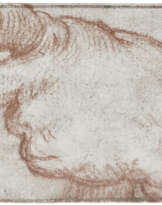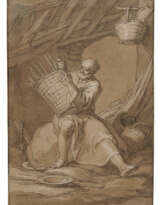ID 1072381
Lot 1210 | Abraham Bloemaert. Madonna with Child
Valeur estimée
€ 10 000 – 15 000
1564 Dordrecht - 1651 Utrecht
Title: Madonna with Child.
Date: 1617.
Technique: Oil on wood.
Measurement: 43 x 34cm.
Notation: Signed and dated upper right: A. Bloemaert / 1617.
Frame: Framed.
Provenance:
Private ownership, Germany.
Finding this plate is a small art historical sensation since it regards one of the most influential Dutch painter of the the late 16th and 17th century: Abraham Bloemaert.
The painting is not only signed, but also dated 1617. It had been in private hands for decades and now that it is once again accessible to the public and researchers, it can help to shed further light on the development of an important artist four hundred years ago.
Abraham Bloemaert was probably born in 1564, the son of a sculptor and architect. Influenced by the art of Frans Floris, Cornelis Spranger, the Fontainebleau School and the Haarlem Mannerists, Bloemaert became one of the leading Mannerist painters of his time in the first half of his life. Around 1610 his painting changed permanently and this new view was opened up to the over 50-year-old master - quite uncharacteristically - by his former pupils.
Abraham Bloemaert was an extremely interested and influential teacher. He is considered the "father of the Utrecht school". Apart from four of his sons, 29 pupils are known in documents, but it is assumed that there were rather about 100 painters whose careers began in Bloemaert's workshop or who accompanied it for a time - among them Hendrick ter Brugghen, Gerard van Honthorst, and Jan Bijlert. It was these students who, after training with "Master Bloemhaert", moved to Italy, where they received an immense impetus from Caravaggio's art and in turn brought this completely new way of seeing and painting back home: The Utrecht Caravaggists. Hendrick ter Brugghen returned to Utrecht as early as 1615 and it can be assumed that he made contact with Abraham Bloemaert again.
Our dated devotional picture was created just at this time, in 1617. The bust of Mary fills almost the entire picture space. She does not present the boy Jesus as the future saviour, but lets her gaze rest on the child. Mother and child are completely concentrated on each other.
Mary is not surrounded by a halo. A red ribbon braided into her hair, which also holds the headscarf, transfers its presence into a completely earthly function. If Mary were not recognisable by the red robe and the ultramarine blue cloak, the painting could also be a depiction of the intimate maternal love of some young woman.
Stylistically, Bloemaert has already changed his depiction here in many aspects from the mannerist more to a naturalistic physicality of the persons.
Mary's neck is no longer overlong, as in earlier depictions, her hand and the child's limbs correspond to natural proportions. The facial features of the Mother of God, however, are still idealised and stylised. The light is also used in such a way that a glow seems to emanate from the face. This is not a portrait. For all the naturalness that has been achieved, there remains an artificial delicacy.
In a thematically identical devotional picture (today Tokyo, Fuji Art Museum), probably painted a few years later, this development is clearly more advanced. The everydayness of the sacred persons, which Caravaggio revolutionarily introduced into art, was here so convincingly realised by Abraham Bloemaert that the Tokyo painting is also encountered profaned in specialist literature under the title Mother with Infant.
The signed and dated Mary with Child represents an exciting connecting element between the Mannerist and the Baroque depiction of the person by the "Father of the Utrecht School".
We are grateful to Gero Seelig, Schwerin, for his support while cataloguing who confirmed the attribution of the present painting on the basis of a high-resolution digital photograph.
| Artiste: | Abraham Bloemaert (1564 - 1651) |
|---|---|
| Technique appliquée: | Huile |
| Catégorie maison de vente aux enchères: | Vieux maîtres |
| Artiste: | Abraham Bloemaert (1564 - 1651) |
|---|---|
| Technique appliquée: | Huile |
| Catégorie maison de vente aux enchères: | Vieux maîtres |
| Adresse de l'enchère |
VAN HAM Kunstauktionen GmbH Hitzelerstr. 2 50968 Köln Allemagne | ||||||||||||||
|---|---|---|---|---|---|---|---|---|---|---|---|---|---|---|---|
| Aperçu |
| ||||||||||||||
| Téléphone | +49 221 92586215 | ||||||||||||||
| Fax | +49 221 92 58 62 4 | ||||||||||||||
| Commission | 32% | ||||||||||||||
| Conditions d'utilisation | Conditions d'utilisation | ||||||||||||||
| Heures d'ouverture | Heures d'ouverture
|














